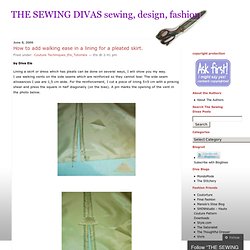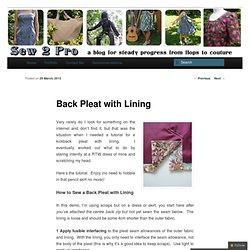

Zippers. Elastic waist. A Different Kind of Waist Stay. I mentioned the other day that this pattern, McCalls 7743, has a waist stay built into the dress.

It’s constructed in a different way than the method I picture when I think ‘waist stay’ so I wanted to show you how it was done. It’s really quite smart, you sew seam binding into the skirt’s waistline seam, edge-stitching the top and bottom so it’s nice and strong, and then when the bodice and skirt are sewn together, there’s a stable, thick waistline seam in there to accentuate the waistline and strengthen that area of the garment. This is what I love about vintage sewing patterns, there’s always a few little gems in there, construction methods that we don’t see that often in simple modern sewing patterns. If you have a dress with a waistline seam, you could add this to your project too!
Skirt Pattern Calculator. A 60cm long, 50° skirt, made 3cm wider in the waist to allow for darts in the back.

Here's a quick pattern calculator that tells you how to make two main arc pieces for a simple flared skirt. It does not consider seams, hems, or seam allowance, but you can figure that out on your own. Instructions Use the 'results' to measure out two identical pieces. Sew the straight edges together, and you've got a skirt! The 'degrees' you put in will determine how much flare the skirt's got. On the other hand, if you put in more than 180 degrees, the tape measure will go inside the fabric and swing around the top: (click on either image to see full size) Keeping lace undarted in a fitted skirt. My lace design has regular repeating rows of curlicues, scrolls and flower motifs that I felt would have been spoiled by waist shaping darts; also the lace fabric is quite thick and darts would not have sat nice and flat on the inside.

Plus, they would have been visible through the wide holes in the lace. SO, I aimed to eliminate the darts from my skirt and maintain the integrity of the rows of repeating motifs in the design. Thank you so much to Robyn and Sharon who asked :)And I should mention straight off that I learnt this process from using Tomoko Nakamichi's Pattern Magic books of course...the point of which is to learn how to manipulate a sloper and fabrics in order to achieve a desired effect. I probably say that each and every time I mention the books, so please forgive me for repeating myself. Add walking ease in a lining. How to add walking ease in a lining for a pleated skirt. by Diva Els Lining a skirt or dress which has pleats can be done on several ways, I will show you my way.

I use walking vents on the side seams which are reinforced so they cannot tear. The side seam allowances I use are 1,5 cm wide. Tips on How to Sew Jeans. Sallie of Sallie-Oh is one awesome awesome lady.

She’s more than just another blog “friend,” she’s a fellow Philadelphian (well, not anymore but she used to be, which is good enough in my book). Our emails back and forth cover more than blogging garb. We chat about familiar Philly neighborhoods, yummy Philly eats, and the bittersweet move of the Barnes Foundation (it houses more Degas than the Louvre!) From the suburbs to the city. What I love most about Sallie is that all of her creations look store bought and RTW and never homemade. Pencil Skirt: Construction. One of the reasons I'm so proud of this skirt (aside from the fact that it's awesome) is because I put a lot of thought and consideration into it.
All too often, I rush headlong into a project without thinking things through, and then don't get the stellar result I was hoping for. This time, at each stage I stopped to consider how to proceed. My original intent was to make this a lined skirt, just because I usually line skirts. But after I stopped to think about it, I realized a few things: one, this is stretch fabric, and I didn't have any stretch lining.
Also: it's denim. Here's a quick rundown of the order in which I constructed the skirt - it's a little different from the instructions (which I've now read). 1. It looks like a lot of steps, but they're all easy, short steps :-) And of course there's pressing after each step. Now, some particulars. Adding a Kick Pleat to an A-line Skirt Pattern. Back Pleat with Lining. Very rarely do I look for something on the internet and don’t find it, but that was the situation when I needed a tutorial for a kickback pleat with lining.

I eventually worked out what to do by staring intently at a RTW dress of mine and scratching my head. Here’s the tutorial. Enjoy (no need to hobble in that pencil skirt no more)! How to Sew a Back Pleat with Lining In this demo, I’m using scraps but on a dress or skirt, you start here after you’ve attached the centre back zip but not yet sewn the seam below. 1 Apply fusible interfacing to the pleat seam allowances of the outer fabric and lining. 2 Hem the lining 3 Apply tailor tacks at the point where the vertical and the diagonal stitching lines intersect 4 Clip to 2mm of the tailor tacks 5 Pin lining to outer fabric, wrong sides together, matching seams and tailor tacks. 6 Press under seam allowances of fabric and lining on left side of pleat only (i.e. right side of garment) 7 Pin and stitch 9 Clip corner and turn right side out. 13 Done.
Making Belt Loops.